View in other NatureServe Network Field Guides
NatureServe
Montana
Utah
Wyoming
Idaho
Wisconsin
British Columbia
South Carolina
Yukon
California
New York
Colorado Columbine - Aquilegia coerulea
Other Names:
Aquilegia caerulea
Native Species
Global Rank:
G5
State Rank:
S3S4
(see State Rank Reason below)
C-value:
6
Agency Status
USFWS:
USFS:
BLM:
External Links
State Rank Reason (see State Rank above)
Aquilegia coerulea has been found in scattered locations within montane and subalpine habitats of southwestern Montana. Additional observations have been reported in the Bob Marshall Wilderness, but their identification needs verification. Locations of older and newer observations does not suggest a change in its distribution within southwestern Montana. Threats or concerns for Aquilegia coerulea's viability have not been identified and habitat does not appear to be a limiting factor. Current information on locations, population sizes, and threats for Aquilegia coerulea is needed.
- Details on Status Ranking and Review
Range Extent
ScoreF - 20,000-200,000 sq km (~8,000-80,000 sq mi)
Comment36,320 square kilometers
Area of Occupancy
ScoreD - 6-25 4-km2 grid cells
CommentPlant occurs in 23 of the 30,590 4x4 square-kilometer grid cells that cover Montana.
Number of Populations
ScoreC - 21 - 80
Comment28 observations
Number of Occurrences or Percent Area with Good Viability / Ecological Integrity
ScoreB - Very few (1-3) occurrences with excellent or good viability or ecological integrity
Comment3 observations assumed to be of good viability based on a descriptor of 'common'.
Threats
ScoreD - Low
General Description
PLANTS: Herbaceous perennial forbs. Stems grow 20–60 cm. tall. Source: Lesica et al. 2012.
LEAVES: Primarily basal leaves with long-petioles and twice ternate single blades. The ultimate leaf segments are 1-3 cm long. Leaves are glaucous (covered with a whitish-bloom). Source: Lesica et al. 2012.
INFLORESCENCE: An open, leafy-bracted raceme with several, erect flowers. Sepals are 5, petal-like, white to pale blue, and about 3 cm long. Petals are 5, white, smaller than sepals, but expand behind their point of attachment into a nectar-bearing spur. The spur is gently curved and about 3-4 cm long. Source: Lesica et al. 2012.
Montana’s plants are variety ochroleuca.
Species Range
Montana Range
Range Descriptions

 Native
Native
Range Comments
Montana to California and Arizona (Lesica et al. 2012).
Observations in Montana Natural Heritage Program Database
Number of Observations: 36
(Click on the following maps and charts to see full sized version)
Map Help and Descriptions
Relative Density
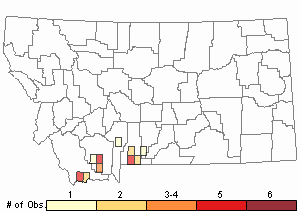
Recency
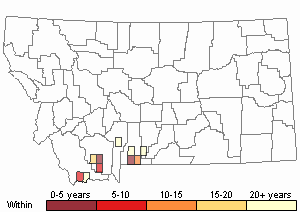
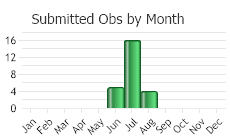
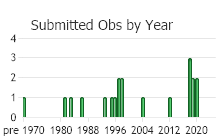
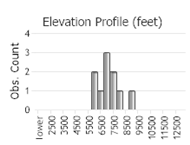 (Observations spanning multiple months or years are excluded from time charts)
(Observations spanning multiple months or years are excluded from time charts)
Habitat
Moist meadows and open forest in the montane and lower subalpine zones (Lesica et al. 2012).
Ecology
POLLINATORS The following animal species have been reported as pollinators of this plant species or its genus where their geographic ranges overlap:
Bombus vagans,
Bombus sitkensis, and
Bombus impatiens (Macior 1968, Thorp et al. 1983, Colla and Dumesh 2010).
Reproductive Characteristics
FRUIT [Source: Lesica et al. 2012]
An aggregate of follicles and many-seeded. Fruits are 2-3 cm long.
Stewardship Responsibility
References
- Literature Cited AboveLegend:
 View Online Publication
View Online Publication Colla, S.R. and S. Dumesh. 2010. The bumble bees of southern Ontario: notes on natural history and distribution. Journal of the Entomological Society of Ontario 141:39-68.
Colla, S.R. and S. Dumesh. 2010. The bumble bees of southern Ontario: notes on natural history and distribution. Journal of the Entomological Society of Ontario 141:39-68. Lesica, P., M.T. Lavin, and P.F. Stickney. 2012. Manual of Montana Vascular Plants. Fort Worth, TX: BRIT Press. viii + 771 p.
Lesica, P., M.T. Lavin, and P.F. Stickney. 2012. Manual of Montana Vascular Plants. Fort Worth, TX: BRIT Press. viii + 771 p. Macior, L.M. 1968. Bombus (Hymenoptera, Apidae) queen foraging in relation to vernal pollination in Wisconsin. Ecology 49:20-25.
Macior, L.M. 1968. Bombus (Hymenoptera, Apidae) queen foraging in relation to vernal pollination in Wisconsin. Ecology 49:20-25. Thorp, R.W., D.S. Horning, and L.L. Dunning. 1983. Bumble bees and cuckoo bumble bees of California (Hymenoptera: Apidae). Bulletin of the California Insect Survey 23:1-79.
Thorp, R.W., D.S. Horning, and L.L. Dunning. 1983. Bumble bees and cuckoo bumble bees of California (Hymenoptera: Apidae). Bulletin of the California Insect Survey 23:1-79.
- Additional ReferencesLegend:
 View Online Publication
View Online Publication
Do you know of a citation we're missing? King, C. R. 1953. The Ranunculaceae of Montana. M.S. Thesis, Bozeman, MT: Montana State College. 82 p.
King, C. R. 1953. The Ranunculaceae of Montana. M.S. Thesis, Bozeman, MT: Montana State College. 82 p. Lesica, P., M.T. Lavin, and P.F. Stickney. 2022. Manual of Montana Vascular Plants, Second Edition. Fort Worth, TX: BRIT Press. viii + 779 p.
Lesica, P., M.T. Lavin, and P.F. Stickney. 2022. Manual of Montana Vascular Plants, Second Edition. Fort Worth, TX: BRIT Press. viii + 779 p. Schwend, Ann C. 1995. Sclerotium spp for biological control of tall larkspur (Delphinium spp). M.Sc. Thesis. Bozeman, MT: Montana State University. 98 p.
Schwend, Ann C. 1995. Sclerotium spp for biological control of tall larkspur (Delphinium spp). M.Sc. Thesis. Bozeman, MT: Montana State University. 98 p.
- Web Search Engines for Articles on "Colorado Columbine"





